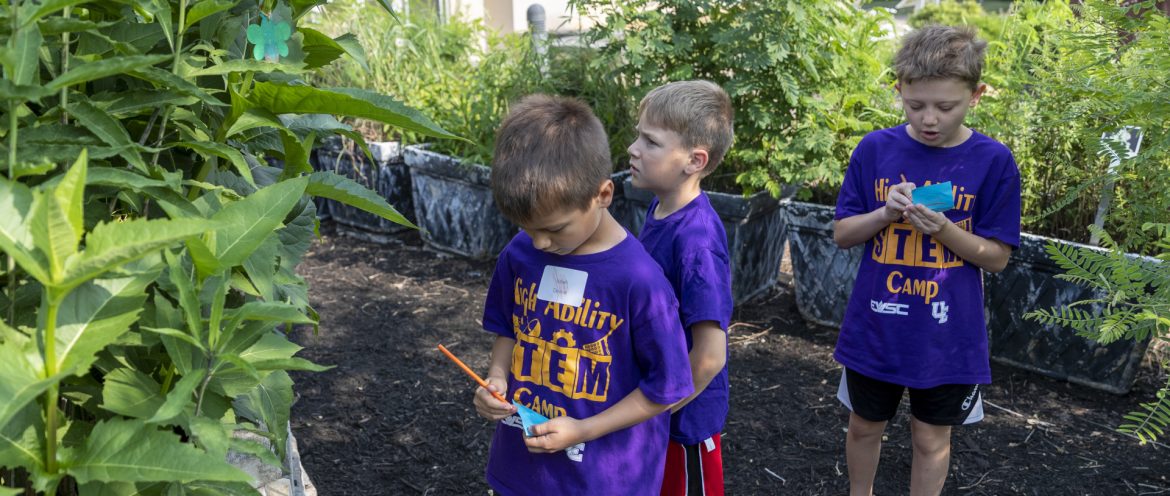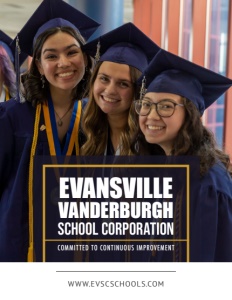The Evansville Vanderburgh School Corporation
Committed to continuous improvement
A recognized leader in neuroeducation
The Evansville Vanderburgh School Corporation (EVSC), a dynamic and progressive public school corporation, proudly serves the city of Evansville and the entirety of Vanderburgh County in the southwestern part of Indiana.
The third largest school district in the state, the EVSC serves approximately 22,000 students in 40 different schools, including elementary, middle, K-8 and high schools. This includes a career and technical center that draws students from eight other school corporations across four other counties. The district has 3,400 employees, over 1,600 of whom are teachers.
A leader in innovative education
In 2011, Dr. David B. Smith was appointed Superintendent of the EVSC after serving 29 years in a variety of roles in the district from teacher to principal, to interim deputy superintendent, to assistant superintendent for business and human resources, to his current role as leader. Under Smith’s guidance, the EVSC has achieved national prominence in the development of unique, innovative school models, and is especially recognized as a leader in the implementation of recent advances in the field of neuroeducation through its utilization of the GAIN (Growth in Academics through Innovation and Neuroeducation) framework.
GAIN’s approach is to support healthy, whole student development with the goal for students to graduate high school with the cognitive, academic, executive functioning, and employability skills needed to be successful at work, at home, and in the community.
“We have learned so much in the last fifteen to twenty years, primarily through neuro-imaging and medical science about brain development and how children learn,” Smith explains. “What we know is that traditional pedagogical practices seem to be pretty devoid of that understanding. So, what we have tried to do is align all of our thinking, and the decisions that we make, through the lens of how children learn; how they develop; and how the brain needs to be in a healthy state to take on the act of cognition.”
Neuroeducation in the early grades
Susan Phelps is EVSC’s Chief Officer of Neuroeducation, having worked for the district since 2010 as a psychologist and director of behavior support. Her task in her current role is to leverage the knowledge gleaned from neuroscience in determining how it can be applied in the classroom where it can impact students, allowing them to develop to their maximum potential.
She notes that the GAIN platform does not replace the curriculum in any way, but rather provides systems and practices that ensure that children have mastered the essential skills that are a precursor to learning.
Smith provides an example of a young student who may be struggling in math. Traditional pedagogy would normally intervene to simply provide more and better math instruction to break through a seeming inability to learn basic math concepts. Yet the problem for this particular student may be a lack of what’s known as “executive functioning skills,” which would normally allow him to pay attention, plan and organize thoughts, follow multi-step directions, have a working, short-term memory, and deal with the stress of absorbing new information.
“If the student is missing some of those executive functioning skills; doesn’t have working memory, say, where he can work with a particular component for at least 12 seconds, and then leverage that for future learning, he’s going to struggle. And it doesn’t matter how good the content is.”
To ensure all students have the executive functioning skills needed to be successful, the EVSC
assessed all of its kindergarten students via the Minnesota Executive Functioning Scale (MEFS), a performance based assessment of executive functioning skills . “Now we have baseline data on that,” says Smith. “We can identify individuals who have deficiencies in executive functioning skills, and by isolating and building upon those skills, we can ensure they will have the executive functioning foundation necessary to take on the content and make it their own.”

High school and beyond
At the other end of a student’s educational journey in the EVSC, the district provides many options for high schoolers to acquire the real-world skills that will prepare them for college or employment. “Our district is rich in dual credit and AP (Advanced Placement) opportunities for students,” notes Dr. Darla Hoover, EVSC’s Chief of Schools and Instructional Core. EVSC offers approximately 30 AP courses and more than 100 different dual credit courses from a variety of institutions including the University of Southern Indiana, Ivy Tech, Vincennes University, and Indiana University-Purdue University Indianapolis.
“Something else that we’re particularly proud of is our investment in Career and Technical Education (CTE),” Hoover adds. “We have 21 different programs of study that students can choose from at our Career Center. We have industry partners, such as Berry Global (a Fortune 500 global manufacturer and marketer of plastic packaging products) Toyota, and Ascension and Deaconess Healthcare systems partnering with us to develop the next generation of industry leaders.
The partnership with Berry Global is in supply chain and logistics. We have students who attend a program offsite with Berry’s instructors. Our program with Toyota, which is in advanced manufacturing and robotics, is housed inside one of our high schools. We want to make sure we are providing programs that students have a high level of interest in, but also based on job outlook and job forecasting. So, we’re trying to strike a balance among community needs, global needs, and student interest.”
Carrie Hillyard is the EVSC’s Transformation Officer. Her focus is on district improvement and innovation. One of the goals of innovation under her leadership is to increase access to career pathways and expand opportunities after high school for EVSC students. So, the district developed a new department called OptIN. “It stands for Opportunities through Partnerships that Transform and Inspire,” Hillyard says.
“The purpose is to think about how we collaborate within the community to expand those partnership opportunities and set students up for post-secondary success. We have partners from local governmental leadership, industry, military, and higher education at the table working together to think about how we expand options and opportunities for students.”
More specifically, OptIN’s goals are to: help students develop essential, in-demand skills that are necessary in today’s workforce that are aligned with students’ interests and strengths; increase student engagement in school; give students a clear path for graduation; match EVSC students with high-quality post-secondary options; and educate students and parents on the career options available to them and the skills necessary to be successful in whatever future career EVSC students choose.
“The first foray into that venture was with AmeriQual,” says Smith. “They’re known for making ready-to-eat meals. We took students who were the most at-risk to not graduate with a high school diploma. We have them for four hours a day where they can do credit recovery and advancement, and then AmeriQual has them as employees for four hours a day while students earn and learn simultaneously with on-the-job training.”
“All of their classes are embedded at AmeriQual onsite with our teaching staff,” says Hillyard. “So, the students still have their core 40 credits needed in Indiana to graduate, but they’re also able to spend a portion of their day at an innovative model, where, oftentimes, they are earning college credit and high school credit, simultaneously, in their area of interest.”
Mental health support
The EVSC is also concerned with students’ mental health. It partners with a local social services organization in Evansville called Youth First. “They provide social workers for our schools,” Smith shares. “We have Youth First social workers in 32 of our 40 buildings and we have EVSC social workers in our other buildings. But every building has at least one, highly trained MSW social worker. That has been incredibly beneficial.
“We have counselors and social workers for students that may need additional support, but, universally, we have systems and practices in place to ensure wellness for all of our students,” says Phelps. The district has created a curriculum to develop students’ social, emotional, prosocial, and cognitive self-regulation skills. This curriculum, in part, develops resilience and agency so our students can persist when there are academic or social challenges.

Infrastructure and Technology
School districts are more than just their human inhabitants. They contain the buildings and other physical structures that must be constructed and maintained. “We have 5.1 million square feet under roof and we take on improvements based upon the demonstrated needs of our buildings,” says Smith.
“We have upgraded our schools with safety and security in mind; we built a new elementary school and it’s the safest structure in our entire county. I know that’s important to parents. We have several solar fields that will pay for themselves once they’re paid for and that additional money comes into EVSC. We’ve replaced all our lighting with LED lights; we’ve upgraded all of our water fixtures with water-reducing fixtures so the savings pay for the projects themselves.”
EVSC schools are also equipped with modern technology. Its high schools have been 1:1, meaning each student has his or her learning device, since 2008.
“At the time, I think it was the second largest deployment of 1:1 devices in the nation,” says Smith. “And we’ve been 1:1 in K-12 for a dozen years or so. We certainly do embrace technology, but we do it so that students know how to use it as a tool and be lifelong learners. We’re also, now, seeing how we can embrace AI (Artificial Intelligence). Some challenges lie ahead when it comes to AI, but the potential for good vastly outweighs areas where it can be misused. Our responsibility is to find a way to help students, in an educated way, to know how to utilize AI.”
The EVSC Ethos
Dr. Smith articulates his guiding principles and those of the Evansville Vanderburgh School Corporation: “We are a district that not only embraces but lives by continuous improvement. We have an unwavering commitment to getting better. That is the connecting thread. When you marry our thirst for continuous improvement, inherent in that is a requirement that you be very reflective in practice and very humble because you only get better by working on those areas where you have those opportunities for improvement.
“On a more specific level, my mantra has been ‘clarity, action, and accountability.’ I want to be incredibly clear about the paths forward so that everyone understands, unequivocally, what we stand for and how we’re going to move forward. Action speaks to your belief. True leaders are clear in their actions so that you know exactly what their beliefs are, and what their north star is.
In terms of accountability, we have to make certain that we hold everyone accountable including ourselves. That takes an incredible amount of trust and collaboration and faith in one another.”
Finally, when it comes to his students, Smith has this to say: “I want to make certain that our students are developed to the full extent so that they can do whatever they choose to do in their life. We know that they will have many different opportunities for different jobs throughout various stages of their life, but I want them to know how to learn and be those lifelong learners so that they will be prepared for anything that comes their way.”
AT A GLANCE
The Evansville Vanderburgh School Corporation
WHAT: A public school district with 22,000 students
WHERE: The city of Evansville and Vanderburgh County, Indiana
WEBSITE: www.evscschools.com


